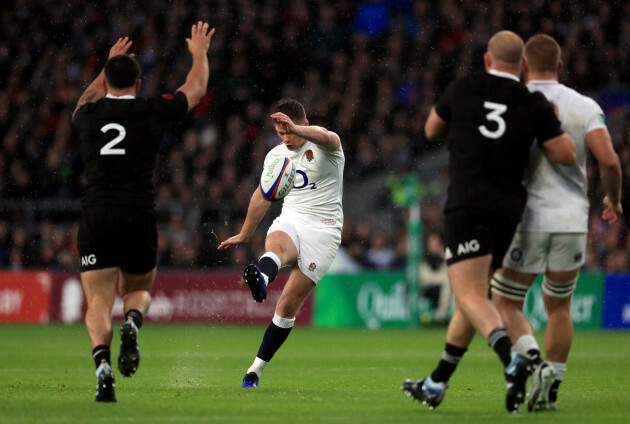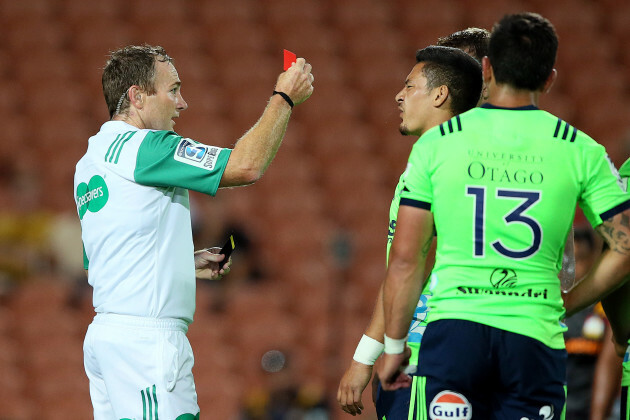WORLD RUGBY WILL consider trialing a potentially revolutionary kicking law and a yellow card upgrade system as it looks to make rugby safer to play.
New law trial suggestions were gathered at the World Rugby Player Welfare and Law Symposium, held over three days this week at the French Rugby Federation’s headquarters in Marcoussis, close to Paris.
Leading coaches like the All Blacks’ Ian Foster and South Africa’s Jacques Nienaber were present, as well as International Rugby Players representatives Jean de Villiers, Thierry Dusautoir and Conrad Smith, and officials from the leading unions and competitions.
The Symposium heard encouraging evidence that the incidence of injuries is not increasing across the world’s elite competitions, while concussion decreased in the 2017/18 season, although injury severity has been on the rise in several nations.
“The injury rates are pretty stable but we need to be ambitious about dropping those injury rates as best we can,” said World Rugby CEO Brett Gosper on Wednesday.
Concussion remains the most common match injury and most pressing issue for rugby, with the tackle producing the majority of concussions.
World Rugby’s data says the tackle accounts for 76% of all concussions, with 72% of concussions sustained by the tackler.
While the governing body will continue to push a clampdown on illegal high tackles – a simplified framework for sanctioning dangerous tackles is set to be revealed soon – law change suggestions were also welcomed at the Symposium.
One of the biggest on-pitch trends in rugby over the past decade has been the increased prevalence of aggressive ‘linespeed’ in defence, with teams filling their defensive line with up to 14 players and rushing forward into tackles – a situation where poor technique is particularly exposed.
Reducing the number of players in the defensive frontline was discussed at the Symposium, leading to the suggestion of a ’50/22′ law for kicking.
This would be a simple tweak whereby a kick from within your own half [your own 50-metre area] that bounces in the field of play before crossing the touchline in the opposition 22 would result in the kicking team getting the throw into the lineout.
An adaptation of the 40/20 kick in rugby league, the hope would be that the threat of these kicks would see defences keep more players in the backfield in order to prevent the kicking team securing an advantageous attacking lineout in the 22.
That, in turn, could produce more space in the defensive frontline and mean fewer tackle events.
The 50/22 law amendment suggestion was popular at the Symposium and it would be no surprise to see it brought forward to the trial phase in the next cycle after this year’s World Cup.
Another suggestion that will be presented to World Rugby’s Law Review Group [LRG] is that yellow cards would be followed by in-game reviews by the citing commissioner, who would have the possibility of upgrading the sanction to a red card within the 10-minute sin-bin window.
The intention would be to ensure a greater number of correct red cards for foul play and fewer incidences of teams losing the in-game benefit they may be missing out on when referees erroneously show yellow cards to the opposition instead of reds.
In total, eight law suggestions [the FFR will carry two of their own in amateur rugby] from the Symposium will be presented to World Rugby’s LRG – others focus on the offside line, the number of substitutions, and committing players to rucks – who will meet in May to begin discussing possible law trials to be launched in 2020.
“There will be unintended consequences, unforeseen consequences – good and bad – that we’ll just have to wait to see when we get into a trial situation,” said Gosper.
The recent trials around tackle height were also examined at this week’s Symposium, with the likelihood being that the ‘high tackle warning system’ used at last year’s World Rugby U20 Championship will be trialed in another elite competition.
The U20 Championship in June saw citing commissioners issuing ‘high-tackle warnings’ to any players who were deemed to have been “upright [not bent at the waist]” in tackles.
Each high tackle warning counted as ‘one strike,’ with two strikes meaning that a player would be suspended for one game.
In total, 11 high tackle warnings were issued at the U20 Championship, with no player receiving two, and the medical data from the tournament shows that the warning system reduced the concussion incidence by 50%.
Encouraged by that reduction but aware of the small study size, World Rugby presented further information at the Symposium and is now hopeful that one of the leading elite senior professional competitions will carry the trial.
Outside of that trial, there is still some sense that high tackles are not being punished severely enough, with statistics showing that players are more likely to receive yellow cards for deliberate knock-ons or ‘not back 10 metres’ offences than they are for dangerous high tackles.
That said, the backlash that first greeted the increased focus on tackle height – some arguing that “rugby is going soft” – has faded in recent times, with fans, players, coaches, and the media now seemingly more surprised when cards aren’t shown after illegal high tackles.
“I think it’s gone well,” said Gosper. “Sometimes there’s been some issues around execution but the intent is there and the understanding of the high tackle danger is much clearer. We’re adding more clarity with the process we’ve been through over the past few days.
“We know cards change behaviour and player welfare is so important you have to be willing to do that. Our role is to give the match officials the confidence to do what they need to do.”
The Symposium involved further presentations, panels, and workshops on injury surveillance, anti-doping, and age grade and community rugby issues.
Player workload was another key focus, with World Rugby now ensuring that every player competing at the World Cup this year must have a ‘‘load passport’ to monitor their training load management between club and country commitments.
All in all, the Symposium was a positive and productive meeting of key figures in the game, with the focus on improving the safety of rugby offering real encouragement.
“What’s unique about this particular symposium was how we could get all of those groups of different stakeholders and experts into the same room,” said Gosper.
“So rather than just look at the laws [to improve the game as a spectacle] and then [look at] whether it has a player welfare impact, try to devise laws that have a direct player welfare impact.
“That’s the first time we’ve looked at it in that sense and we saw the theme of the meeting: spectacle versus player welfare.
“This is really about looking at the shape of the game and working out what can actually have a material effect on some of the outcomes we’re having in the injury rates.
“Involving the leagues is important as well because these trials need to land in meaningful competitions. If they don’t land in meaningful competitions, they don’t trial as well as they should but I think there’s a collective will to do this in the right way and that was part of the reason for having this here as well.”
Subscribe to our new podcast, The42 Rugby Weekly, here:




